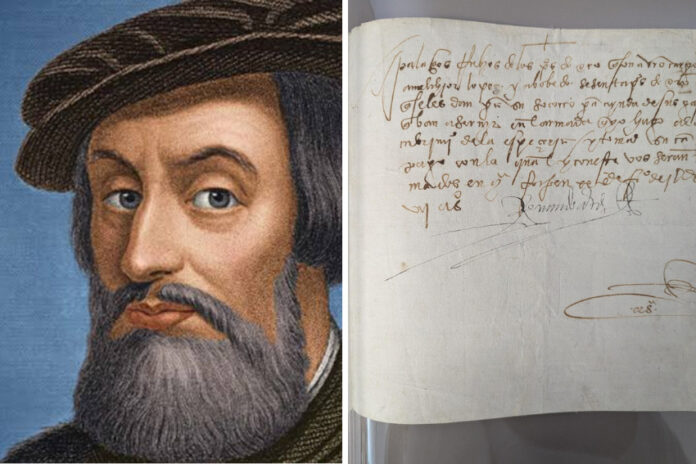A stolen manuscript signed by Spanish conquistador Hernán Cortés is back in Mexico after a binational investigation traced the document to the U.S.
Nearly five centuries after Cortés affixed his signature to the page, the U.S. Federal Bureau of Investigation (FBI) handed the priceless cultural artifact back to Mexico.
Today, the FBI returned a stolen manuscript signed by Spanish conquistador Hernán Cortés to the government of Mexico.
The repatriation of this priceless cultural artifact—which authorities believe was stolen in the 1980s or 1990s—was the result of close collaboration between… pic.twitter.com/OCuOIOqkUm
— FBI (@FBI) August 13, 2025
José Alfonso Suárez y Real, a spokesman for President Claudia Sheinbaum, on Thursday voiced appreciation for the return of the document, while the U.S. Embassy in Mexico praised the cross-border collaboration in a social media statement posted on Wednesday.
In a press release, U.S. Special Agent Jessica Dittmer, described the document as “an original manuscript page that was actually signed by Hernán Cortés on February 20, 1527.”
A member of the FBI’s Art Crime Team based in New York City, Dittmer said the document “outlines the payment of pesos of common gold for expenses in preparation for discovery of the spice lands.”
The manuscript also contains a detailed accounting of the logistics related to Cortés’ journey to what eventually became New Spain.
“Pieces like this are considered protected cultural property and represent valuable moments in Mexico’s history,” Dittmer said.
The newspaper The Guardian reported that the document was signed “just days before one of Cortés’ top lieutenants was appointed co-governor of the conquered territory.”
The Guardian further described 1527 as “a key year for the formation of royal and religious institutions that would rule over the Indigenous peoples of Mexico until its 1810-21 war of independence.”
The repatriation of the priceless document was the result of close collaboration between the FBI, the New York City Police Department (NYPD), the U.S. Department of Justice and the Mexican government.
“This could not have been possible without the collaboration of … the FBI’s attaché office in Mexico … a valuable liaison between FBI personnel within the United States and … our foreign partners,” said NYPD Det. Rigel Zeledon, who helped Dittmer with the investigation.
Investigators believe the manuscript was stolen in the 1980s or 1990s, identifying the presence of wax numbering marks, a system used by Mexican archivists at that time. The FBI said these exacting details not only helped investigators find the document but also helped to authenticate it.

The FBI said Mexico’s National Archives “originally counted the repatriated manuscript among a collection of historical documents hand-signed by Cortés,” only to realize that 15 pages of the document was missing when an inventory was carried out while microfilming the collection in October 1993.
However, Mexico did not request the assistance of the FBI’s art crime team until last year, asking for help in finding the particular page returned on Wednesday.
The FBI says it is resolved to locate and repatriate the other missing pages.
“The United States — for better or for worse — is one of the largest, if not the largest, consumer of art and antiquities,” FBI Supervisory Special Agent Veh Bezdikian said in the press release. “We know how important it is for the United States to stay ahead of this, to support our foreign partners, and to try and make an impact as it relates to the trafficking of these artistic works and antiquities.”
The FBI said that open-source research suggested the missing manuscript was located in the continental United States, with the investigation narrowing in on stakeholders formerly and currently in possession of the manuscript page.
Investigators declined to disclose who was in possession of the document. And because they determined that the manuscript “changed hands several times over” in the decades since its disappearance, the FBI said no one will face prosecution.
FBI Boston recovers stolen manuscript signed by Hernán Cortés
This is the second time in two years that the FBI has returned a stolen Cortés document to Mexico. In July 2023, a 16th century letter from the conquistador that authorized a purchase of rose sugar was repatriated.
In 2022, a National Archives employee discovered that this manuscript — dated May 27, 1527 — was set to be auctioned in Boston in one week’s time. U.S. authorities halted the auction and gained possession of the document, which had received 22 bids and was on the verge of being sold for US $18,600.
With reports from El País, La Jornada, El Universal and The Guardian
